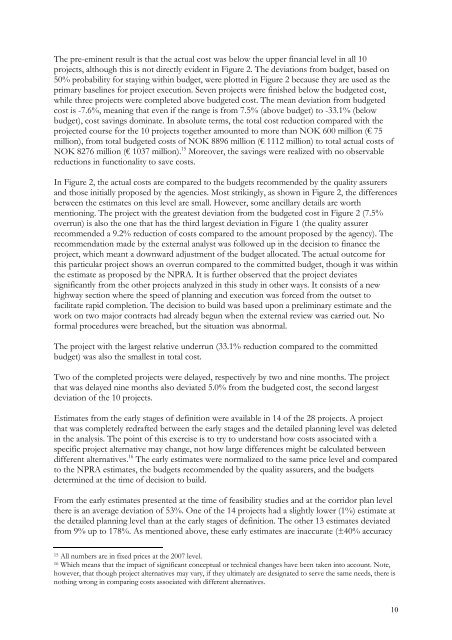Link to thesis. - Concept - NTNU
Link to thesis. - Concept - NTNU
Link to thesis. - Concept - NTNU
- No tags were found...
You also want an ePaper? Increase the reach of your titles
YUMPU automatically turns print PDFs into web optimized ePapers that Google loves.
The pre-eminent result is that the actual cost was below the upper financial level in all 10projects, although this is not directly evident in Figure 2. The deviations from budget, based on50% probability for staying within budget, were plotted in Figure 2 because they are used as theprimary baselines for project execution. Seven projects were finished below the budgeted cost,while three projects were completed above budgeted cost. The mean deviation from budgetedcost is -7.6%, meaning that even if the range is from 7.5% (above budget) <strong>to</strong> -33.1% (belowbudget), cost savings dominate. In absolute terms, the <strong>to</strong>tal cost reduction compared with theprojected course for the 10 projects <strong>to</strong>gether amounted <strong>to</strong> more than NOK 600 million (€ 75million), from <strong>to</strong>tal budgeted costs of NOK 8896 million (€ 1112 million) <strong>to</strong> <strong>to</strong>tal actual costs ofNOK 8276 million (€ 1037 million). 15 Moreover, the savings were realized with no observablereductions in functionality <strong>to</strong> save costs.In Figure 2, the actual costs are compared <strong>to</strong> the budgets recommended by the quality assurersand those initially proposed by the agencies. Most strikingly, as shown in Figure 2, the differencesbetween the estimates on this level are small. However, some ancillary details are worthmentioning. The project with the greatest deviation from the budgeted cost in Figure 2 (7.5%overrun) is also the one that has the third largest deviation in Figure 1 (the quality assurerrecommended a 9.2% reduction of costs compared <strong>to</strong> the amount proposed by the agency). Therecommendation made by the external analyst was followed up in the decision <strong>to</strong> finance theproject, which meant a downward adjustment of the budget allocated. The actual outcome forthis particular project shows an overrun compared <strong>to</strong> the committed budget, though it was withinthe estimate as proposed by the NPRA. It is further observed that the project deviatessignificantly from the other projects analyzed in this study in other ways. It consists of a newhighway section where the speed of planning and execution was forced from the outset <strong>to</strong>facilitate rapid completion. The decision <strong>to</strong> build was based upon a preliminary estimate and thework on two major contracts had already begun when the external review was carried out. Noformal procedures were breached, but the situation was abnormal.The project with the largest relative underrun (33.1% reduction compared <strong>to</strong> the committedbudget) was also the smallest in <strong>to</strong>tal cost.Two of the completed projects were delayed, respectively by two and nine months. The projectthat was delayed nine months also deviated 5.0% from the budgeted cost, the second largestdeviation of the 10 projects.Estimates from the early stages of definition were available in 14 of the 28 projects. A projectthat was completely redrafted between the early stages and the detailed planning level was deletedin the analysis. The point of this exercise is <strong>to</strong> try <strong>to</strong> understand how costs associated with aspecific project alternative may change, not how large differences might be calculated betweendifferent alternatives. 16 The early estimates were normalized <strong>to</strong> the same price level and compared<strong>to</strong> the NPRA estimates, the budgets recommended by the quality assurers, and the budgetsdetermined at the time of decision <strong>to</strong> build.From the early estimates presented at the time of feasibility studies and at the corridor plan levelthere is an average deviation of 53%. One of the 14 projects had a slightly lower (1%) estimate atthe detailed planning level than at the early stages of definition. The other 13 estimates deviatedfrom 9% up <strong>to</strong> 178%. As mentioned above, these early estimates are inaccurate (±40% accuracy15 All numbers are in fixed prices at the 2007 level.16 Which means that the impact of significant conceptual or technical changes have been taken in<strong>to</strong> account. Note,however, that though project alternatives may vary, if they ultimately are designated <strong>to</strong> serve the same needs, there isnothing wrong in comparing costs associated with different alternatives.10
















